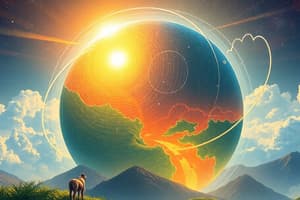Podcast
Questions and Answers
How do Milankovitch cycles influence the Earth's climate?
How do Milankovitch cycles influence the Earth's climate?
- By directly altering the sun's energy output every 11 years.
- By influencing ocean and atmospheric circulation patterns, leading to El Niño and La Niña events.
- By causing volcanic eruptions that release greenhouse gases.
- By changing the Earth's orbit, tilt, and wobble, affecting the distribution and intensity of solar exposure. (correct)
Which of the following factors, besides Milankovitch cycles, contribute to ice age patterns?
Which of the following factors, besides Milankovitch cycles, contribute to ice age patterns?
- Volcanic eruptions and carbon dioxide levels in the atmosphere. (correct)
- The consistent pattern of El Niño and La Niña events.
- The constant and predictable output of solar energy.
- The stability of ocean and atmosphere circulation.
What is the primary effect of the sun's 11-year cycle on Earth's climate?
What is the primary effect of the sun's 11-year cycle on Earth's climate?
- It results in a small fluctuation in Earth's temperature, with minimal long-term impact. (correct)
- It triggers significant changes in ocean currents, influencing El Niño and La Niña events.
- It leads to increased volcanic activity, affecting global temperatures.
- It causes major shifts in global weather patterns, leading to prolonged droughts.
How do El Niño events typically impact the eastern Pacific region?
How do El Niño events typically impact the eastern Pacific region?
What characterizes La Niña events in the eastern Pacific?
What characterizes La Niña events in the eastern Pacific?
What is the scientific consensus regarding the cause of El Niño and La Niña cycles?
What is the scientific consensus regarding the cause of El Niño and La Niña cycles?
Which statement accurately describes the relationship between El Niño/La Niña and sea levels?
Which statement accurately describes the relationship between El Niño/La Niña and sea levels?
What is the primary distinction between weather and climate?
What is the primary distinction between weather and climate?
Why are greenhouse gases like carbon dioxide considered significant contributors to climate change?
Why are greenhouse gases like carbon dioxide considered significant contributors to climate change?
What evidence suggests that current global warming exceeds natural climate variation?
What evidence suggests that current global warming exceeds natural climate variation?
What best describes the Milankovitch cycles?
What best describes the Milankovitch cycles?
How does the change in Earth's orbit from nearly circular to elliptical affect climate?
How does the change in Earth's orbit from nearly circular to elliptical affect climate?
What is the range of Earth's axial tilt variation over a cycle, and how does this affect climate?
What is the range of Earth's axial tilt variation over a cycle, and how does this affect climate?
How does the 'wobble' of the Earth on its axis (precession) influence climate?
How does the 'wobble' of the Earth on its axis (precession) influence climate?
If scientists observe a climate warming trend that significantly exceeds what Milankovitch cycles would predict, what conclusion might they draw?
If scientists observe a climate warming trend that significantly exceeds what Milankovitch cycles would predict, what conclusion might they draw?
Flashcards
Climate
Climate
Long-term variations in average weather conditions over a wide area.
Greenhouse Gases
Greenhouse Gases
Gases that trap heat in the atmosphere, like a blanket.
Carbon Dioxide (CO2)
Carbon Dioxide (CO2)
The most significant greenhouse gas, now at 400 ppm.
Ice Ages
Ice Ages
Signup and view all the flashcards
Milankovitch Cycles
Milankovitch Cycles
Signup and view all the flashcards
Orbital Shape Change
Orbital Shape Change
Signup and view all the flashcards
Earth's Tilt Variation
Earth's Tilt Variation
Signup and view all the flashcards
Earth's Axial Wobble
Earth's Axial Wobble
Signup and view all the flashcards
Ice Age Cycle Length
Ice Age Cycle Length
Signup and view all the flashcards
Sun Cycle
Sun Cycle
Signup and view all the flashcards
El Niño
El Niño
Signup and view all the flashcards
La Niña
La Niña
Signup and view all the flashcards
Normal Conditions (Pacific)
Normal Conditions (Pacific)
Signup and view all the flashcards
El Niño/La Niña Causes
El Niño/La Niña Causes
Signup and view all the flashcards
Study Notes
- Climate refers to variations in average weather over a wide area and long period.
- Current climate change is unprecedented, with human greenhouse gas emissions as the likely cause.
- Greenhouse gases trap heat in the atmosphere.
- Carbon Dioxide levels have risen from 280 ppm at the start of the Industrial Revolution to 400 ppm.
Natural Climate Cycles
- The earth naturally warms and cools over hundreds of thousands of years.
- Cool periods are known as ice ages, with expanded ice caps.
- To understand current global warming, natural cycles must be accounted for.
- Earth's temperature is warming at a rate faster than would be expected naturally.
Milankovitch Cycles
- Changes in Earth's orbit, tilt, and wobble.
- Earth's orbit changes from circular to elliptical roughly every 100,000 years.
- Earth's tilt varies between 22.1 and 24.5 degrees every 41,000 years.
- The Earth wobbles on its axis every 26,000 years.
- Milankovitch cycles influence ice age formation by affecting the distribution and intensity of sunlight.
- Ice ages occur every 100,000 years presently, but have occurred as frequently as every 26,000 years in the past.
- Other factors influencing ice ages include ocean and atmosphere circulation, volcanoes, and carbon dioxide levels.
Sun Cycles
- Solar output changes on an 11-year cycle.
- The effect of these changes on climate appears to be small, causing only minor temperature variations.
El Niño & La Niña
- El Niño involves strong storms in the east Pacific and west coast of South America due to warm currents moving east.
- El Niño events occur every 3-6 years.
- La Niña is the opposite, causing dry spells in the same regions due to warm currents moving west.
- The causes of changes in currents driving these cycles is a complex mix of factors and an area of continuous study.
Studying That Suits You
Use AI to generate personalized quizzes and flashcards to suit your learning preferences.
Description
Climate change refers to long-term variations in average weather. Current climate change is largely due to human greenhouse gas emissions, primarily carbon dioxide. Natural climate cycles like Milankovitch cycles also influence Earth's temperature, but current warming exceeds natural expectations.




